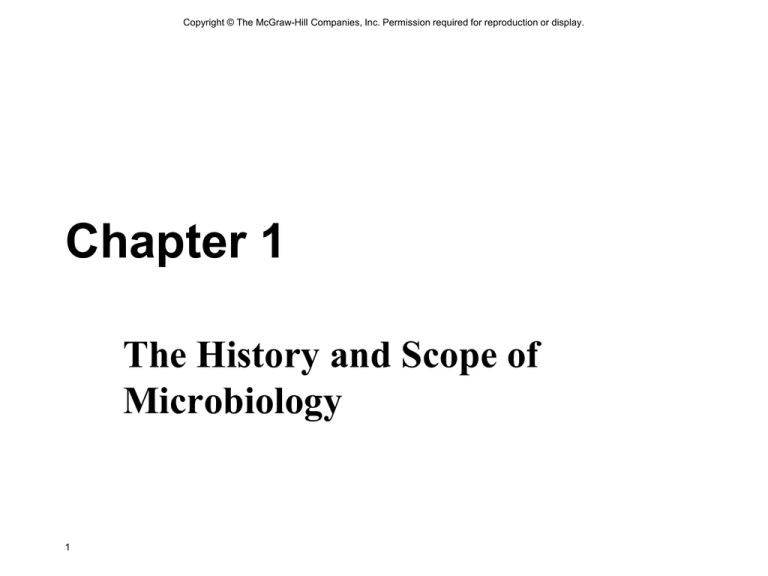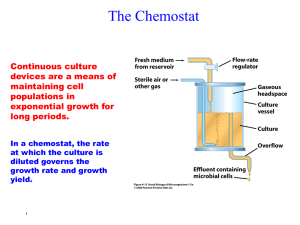Chapter 1
advertisement

Copyright © The McGraw-Hill Companies, Inc. Permission required for reproduction or display. Chapter 1 The History and Scope of Microbiology 1 Copyright © The McGraw-Hill Companies, Inc. Permission required for reproduction or display. The Importance of Microorganisms • most populous group of organisms and are found everywhere on the planet • play a major role in recycling essential elements • source of nutrients and some carry out photosynthesis • benefit society by their production of food, beverages, antibiotics and vitamins 2 Copyright © The McGraw-Hill Companies, Inc. Permission required for reproduction or display. What is microbiology? • study of organisms too small to be clearly seen by the unaided eye (i.e., microorganisms) • these organisms are relatively simple in their construction and lack highly differentiated cells and distinct tissues 3 Copyright © The McGraw-Hill Companies, Inc. Permission required for reproduction or display. Members of the microbial world • procaryotic cells lack a true membrane-delimited nucleus • eucaryotic cells have a membraneenclosed nucleus, are more complex morphologically and are usually larger than procaryotic cells 4 Copyright © The McGraw-Hill Companies, Inc. Permission required for reproduction or display. Classification schemes • five kingdom scheme includes Monera, Protista, Fungi, Animalia and Plantae with microbes placed in the first three kingdoms • three domain alternative, based on a comparison of ribosomal RNA, divides microorganisms into Bacteria (true bacteria), Archaea and Eucarya (eucaryotes) 5 Copyright © The McGraw-Hill Companies, Inc. Permission required for reproduction or display. Figure 1.1 6 Copyright © The McGraw-Hill Companies, Inc. Permission required for reproduction or display. Domain Bacteria – all procaryotic • • • • most are single-celled most have peptidoglycan in cell wall can survive broad range of environments most are non-pathogenic and play major role in nutrient recycling • cyanobacteria produce oxygen as a result of photosynthesis 7 Copyright © The McGraw-Hill Companies, Inc. Permission required for reproduction or display. Domain Archaea – all procaryotic • procaryotic • distinguished from Bacteria by unique ribosomal RNA sequences • lack peptidoglycan in cell wall • many found in extreme environments • no pathogenic species known 8 Copyright © The McGraw-Hill Companies, Inc. Permission required for reproduction or display. Domain Eucarya – all eucaryotic • animals, plants and eucaryotic microorganisms – Microorganisms include protists (unicellular algae, protozoa, slime molds and water molds) and fungi – Most are larger than procaryotic cells 9 Copyright © The McGraw-Hill Companies, Inc. Permission required for reproduction or display. Viruses • acellular • smallest of all microbes • cause a range of diseases including some cancers (e.g. hepatitis B & C) 10 Copyright © The McGraw-Hill Companies, Inc. Permission required for reproduction or display. Figure 1.2a 11 Copyright © The McGraw-Hill Companies, Inc. Permission required for reproduction or display. Figure 1.2b 12 Copyright © The McGraw-Hill Companies, Inc. Permission required for reproduction or display. Figure 1.2c 13 Copyright © The McGraw-Hill Companies, Inc. Permission required for reproduction or display. Discovery of Microorganisms • Antony van Leeuwenhoek (16321723) – first person to observe and describe microorganisms accurately Figure 1.3 (a) 14 Copyright © The McGraw-Hill Companies, Inc. Permission required for reproduction or display. Figure 1.3 (b) and (c) 15 Copyright © The McGraw-Hill Companies, Inc. Permission required for reproduction or display. The Conflict over Spontaneous Generation • spontaneous generation – living organisms can develop from nonliving or decomposing matter • Francesco Redi (1626-1697) – disproved spontaneous generation for large animals – showed that maggots on decaying meat came from fly eggs 16 Copyright © The McGraw-Hill Companies, Inc. Permission required for reproduction or display. But could spontaneous generation be true for microorganisms? • John Needham (1713-1781) – his experiment: mutton broth in flasks boiled sealed – results: broth became cloudy and contained microorganisms • Lazzaro Spallanzani (1729-1799) – his experiment: water and seeds in flasks sealed placed in boiling water for 45 min – results: no growth of microorganisms 17 Copyright © The McGraw-Hill Companies, Inc. Permission required for reproduction or display. Louis Pasteur (1822-1895) • his experiments – filtered air through cotton : found objects resembling plant spores – placed nutrient solution in flasks – created flasks with long, curved necks – boiled the solutions – left flasks exposed to air • results: no growth of microorganisms 18 Copyright © The McGraw-Hill Companies, Inc. Permission required for reproduction or display. Louis Pasteur (1822-1895) Figure 1.4 19 Figure 1.5 Copyright © The McGraw-Hill Companies, Inc. Permission required for reproduction or display. Final blow to theory of spontaneous generation • John Tyndall (1820-1893) – demonstrated that dust carries germs (microorganisms) – showed that if dust was absent, nutrient broths remained sterile, even if directly exposed to air – also provided evidence for the existence of exceptionally heat-resistant forms of bacteria (endospore) 20 Copyright © The McGraw-Hill Companies, Inc. Permission required for reproduction or display. The role of microorganisms in disease • was not immediately obvious • establishing connection depended on development of techniques for studying microbes • once established, led to study of host defenses - immunology 21 Copyright © The McGraw-Hill Companies, Inc. Permission required for reproduction or display. The golden age of microbiology (1857-1914) • Many disease producing organisms discovered • Microbial metabolism studies undertaken • Microbiological techniques refined • A better understanding of the role of immunity and ways to control and prevent infection by microbes 22 Copyright © The McGraw-Hill Companies, Inc. Permission required for reproduction or display. Recognition of the relationship between microorganisms and disease • Agostini Bassi (1773-1856) – showed that a disease of silkworms was caused by a fungus 23 Copyright © The McGraw-Hill Companies, Inc. Permission required for reproduction or display. More evidences… • M. J. Berkeley (ca. 1845) – demonstrated that the great Potato Blight of Ireland was caused by a water mold • Heinrich de Bary (1853) – showed that smut and rust fungi caused cereal crop diseases • Louis Pasteur – showed that the pébrine disease of silkworms was caused by a protozoan 24 Copyright © The McGraw-Hill Companies, Inc. Permission required for reproduction or display. Other evidences… • Joseph Lister – provided indirect evidence that microorganisms were the causal agents of disease – developed a system of surgery designed to prevent microorganisms from entering wounds as well as methods for treating instruments and surgical dressings – his patients had fewer postoperative infections 25 Copyright © The McGraw-Hill Companies, Inc. Permission required for reproduction or display. Final proof… • Robert Koch (1843-1910) – established the relationship between Bacillus anthracis and anthrax – used criteria developed by his teacher Jacob Henle (1809-1895) – these criteria now known as Koch’s postulates • still used today to establish the link between a particular microorganism and a particular disease 26 Copyright © The McGraw-Hill Companies, Inc. Permission required for reproduction or display. Koch’s postulates • The microorganism must be present in every case of the disease but absent from healthy individuals. • The suspected microorganism must be isolated and grown in a pure culture. • The same disease must result when the isolated microorganism is inoculated into a healthy host. • The same microorganism must be isolated again from the diseased host. 27 Copyright © The McGraw-Hill Companies, Inc. Permission required for reproduction or display. Figure 1.6 28 Copyright © The McGraw-Hill Companies, Inc. Permission required for reproduction or display. The development of techniques for studying microbial pathogens • Koch’s work led to discovery or development of: – agar – petri dish – nutrient broth and nutrient agar – methods for isolating microorganisms (streak plate method) 29 Copyright © The McGraw-Hill Companies, Inc. Permission required for reproduction or display. Other developments… • Charles Chamberland (1851-1908) – developed porcelain bacterial filters used by Ivanoski and Beijerinck to study tobacco mosaic disease • determined that extracts from diseased plants had infectious agents present which were smaller than bacteria and passed through the filters • Infectious agents were eventually shown to be viruses 30 Copyright © The McGraw-Hill Companies, Inc. Permission required for reproduction or display. Immunological Studies • Edward Jenner (ca. 1798) – used a vaccination procedure to protect individuals from smallpox * This work preceded the work establishing the role of microorganisms in disease 31 Copyright © The McGraw-Hill Companies, Inc. Permission required for reproduction or display. Other developments… • Pasteur and Roux – discovered that incubation of cultures for long intervals between transfers caused pathogens to lose their ability to cause disease • Pasteur and his coworkers – developed vaccines for chicken cholera, anthrax, and rabies 32 Copyright © The McGraw-Hill Companies, Inc. Permission required for reproduction or display. More developments… • Emil von Behring (1854-1917) and Shibasaburo Kitasato (1852-1931) – developed antitoxins for diphtheria and tetanus – evidence for humoral immunity • Elie Metchnikoff (1845-1916) – discovered bacteria-engulfing phagocytic cells in the blood – evidence for cellular immunity 33 Copyright © The McGraw-Hill Companies, Inc. Permission required for reproduction or display. The Development of Industrial Microbiology and Microbial Ecology • Louis Pasteur – demonstrated that alcohol fermentations and other fermentations were the result of microbial activity – developed the process of pasteurization to preserve wine during storage 34 Copyright © The McGraw-Hill Companies, Inc. Permission required for reproduction or display. Additional Developments… • Sergei Winogradsky (1856-1953) and Martinus Beijerinck (1851-1931) – studied soil microorganisms and discovered numerous interesting metabolic processes (e.g., nitrogen fixation, chemolithotrophy) – pioneered the use of enrichment cultures and selective media 35 Copyright © The McGraw-Hill Companies, Inc. Permission required for reproduction or display. The Scope and Relevance of Microbiology • importance of microorganisms – first living organisms on planet – live everywhere life is possible – more numerous than any other kind of organisms – global ecosystem depends on their activities – influence human society in many ways 36 Copyright © The McGraw-Hill Companies, Inc. Permission required for reproduction or display. Microbiology has basic and applied aspects • Basic aspects are concerned with individual groups of microbes, microbial physiology, genetics, molecular biology and taxonomy • Applied aspects are concerned with practical problems – disease, water, food and industrial microbiology 37 Copyright © The McGraw-Hill Companies, Inc. Permission required for reproduction or display. Microbiology actually represents many fields of study • Examples – medical microbiology is concerned with diseases of humans and animals – immunology is concerned with how the immune system protects a host from pathogens 38 Copyright © The McGraw-Hill Companies, Inc. Permission required for reproduction or display. More fields… – microbial ecology is concerned with the relationship of organisms with their environment – microbial genetics and molecular biology are concerned with the understanding of how genetic information functions and regulates the development of cells and organisms 39 Copyright © The McGraw-Hill Companies, Inc. Permission required for reproduction or display. The Future of Microbiology: Challenges and opportunities for future microbiologists • infectious disease • new and improved industrial processes • microbial diversity and microbial ecology – less than 1% of earth’s microbial population has been cultured 40 Copyright © The McGraw-Hill Companies, Inc. Permission required for reproduction or display. More challenges and opportunities… • • • • 41 biofilms genome analysis microbes as model systems assessment of implications of new discoveries and technologies






